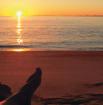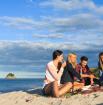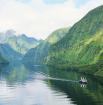Coromandel
Coromandel. It's one of the many places in New Zealand where you'll arrive planning on spending three days, yet one week later you'll still have been unable to tear yourself away. It's an area of idyllic coastlines: white-sand beaches, rocky outcrops, limestone caves and each beach you find will result in you questioning your definition of paradise. Yet Coromandel isn't just a beach paradise, the middle of of peninsula offers a rugged, mountainous spine where you can set off on a number of tramps into the bush.
Coromandel retains a historic feel of its gold mining days with small villages, friendly and laid-back locals and corners that are still relatively untouched by the region's tourism boom. It's an alternative-lifestyle paradise and the place to go if you want to get away from it all; the peninsula offers hippy communes, organic farms, and Buddhist retreats.
Add to all of this fresh seafood, few crowds in the off-season and a variety of quaint and unique budget accommodation and Coromandel quickly becomes one of New Zealand's best areas for independent travellers. Check out Wotif for the best deals on Coromandel accommodation.
Destination Coromandel: Getting There
The Coromandel Peninsula is reached in only a couple hours from Auckland. It's for this reason that the peninsula bursts during the height of summer (December - February). If you're arriving from the South, Rotorua is only a quick two hour drive away.
One main road circumnavigates the peninsula (the SH25) so hitch-hiking is a very reliable way to get around Coromandel. A number of local bus companies offer reliable transport around the Peninsula and many backpackers hostels offer shuttles to nearby attractions.
Destination Coromandel: Orientation
- Thames :: Thames sits at the southwestern edge of the peninsula and serves as Coromandel's main service town. Its roots are based in the 19th Century and at this time it was a thriving town for the nearby gold-mining and Kauri logging. Today, it's still a busy place and retains its historical feel.
- Coromandel :: About an hours driving north following the coast of the Hauraki Gulf will place you in Coromandel Village. Also a booming town in the 19th Century, Coromandel similarly retains its historic feel. It's heaps more quaint than nearby Thames and is the preferred place to base yourself on the peninsula's western coast (assuming you like cozy pubs, hip cafes, laid-back locals, and smoked mussels).
- Whitianga :: Situated on the opposite side of the peninsula only a short hour away is Whitianga. This resort town is where you'll base yourself when traveling to Hot Water Beach or Cathedral Cove. Similar to Northland's Bay of Islands, Whitianga is a water-lovers' paradise with diving, kayaking, fishing and more on offer.
- Whangamata :: Another hours drive South and you'll come to Whangamata. Surfers unite as Whangamata has a terrific 4km long surf beach with a fantastic break by the bar. Similar to the rest of Coromandel, Whangamata is heaving during the high season and a significantly quieter, more peaceful place to spend a couple days in the off-season.
Destination Coromandel: Hot Spots
Be sure to check out any or all of these spots during your time traveling through Coromandel.
Whilst attractions and activities in Coromandel are focused heavily around the sea, trampers, artistic folk, alternative lifestylers and, well, just about anyone can find something in this quintessentially Kiwi region.
Coromandel Forest Park
The Coromandel Forest Park stretches from Cape Colville - Coromandel's northernmost point - all the way south to Paeroa. This often mountainous park serves as the spine to the Coromandel Peninsula with the highest point being Mt Moehau at 892 metres. Views from the summit offer stunning views over the Hauraki Gulf all the way to Auckland's Sky Tower.
Dozens of day walks and tramps cross through the Coromandel Forest Park with the most popular being the 3.5 hour hike to the Pinnaces in the Kauaeranga Valley; these dramatic, jagged, limestone outcrops reach 759 metres.
It's a fantastic walk that crosses streams and swingbridges and pases huge rata trees and nikau palms. If you book with DOC in advance, you can spend the night in the 80 bed Pinnacles Hut. From the summit of the Pinnacles you can expect panoramic views of both coasts with views all they way south to the Bay of Plenty.
Coromandel Town
Coromandel Town is an undeniably quaint little village which almost feels as if it belongs in the Old West of the US. Coromandel's history is rooted in the gold that used to be mined just outside of town; while today much of the town circles around the fishing which is done off Coromandel’s coast.
The drive from Thames to Coromandel is one of the nicest drives in New Zealand - so take your time. The road going north along the Firth of Thames hugs the seaside with many of the corners only allowing room for one vehicle. A sunset drive in December when the pohutukawas are in bloom is about as close to the perfect drive as you could get. Consider stopping for a wee picnic on one of the many pull outs.
You can’t miss out on sampling some local smoked mussels farmed just off Coromandel's coast. They’re delicious and come in a variety of smoked flavors like garlic and chile lime. Try some at the Coromandel Smoking Company as you come into town.
Coromandel is our recommendation of where to base yourself for at least a couple of your days on the Peninsula. A number of walks, cafes with terrific coffee, the Driving Creek Railway (below), and plenty of fresh seafood are sure to keep you busy in this chilled out little hamlet.
Coromandel seems to be stuck in about circa 1980, but that's okay by us...
Driving Creek Railway
The Driving Creek Railyway is proper New Zealand #8 wire mentality at its best. Local Kiwi Barry Brickell spent 15 years building this narrow gauge (15 inches) railway on his sprawling 22 h.a. patch of land just outside of Coromandel Town. Brickell never anticipated his railway becoming a tourist destination, rather he built the railway out of 'necessity.'
Brickell, a potter by trade, thought a railway system through his bush-clad property would be the most efficient and environmentally friendly way to provide all weather access to clay and pine wood kiln fuel.
On the ride to the 165 metre summit, the truly-amazing Driving Creek Railway train runs up steep grades, across four trestle bridges, along two spirals, a double switchback, through two tunnels before finishing at the Eye-full Tower. The 60 minute long trip passes artworks and regenerating native forest – more than 15,000 natives have been planted, including thousands of kauri. It's only $25 and is a must on your trip traveling in Coromandel.
Coromandel Coastal Walkway
As you make your way further north up the peninsula, the crowds and settlements become fewer and farther between. You'll pass Colville - a tiny village home to alternative lifestylers and a Buddhist retreat. Stop in for a coffee in Colville before carrying on to the Coromandel Coastal Walkway.
This three-four hour one way trek takes in views of Great Barrier Island, the Hauraki Gulf and Pacific Ocean and must rank as one of the most beautiful coastal walks on the North Island. A number of Department of Conservation (DOC) campsites along the coastline at Waikawau Bay, Fantail Bay, Stony Bay and Fletchers Bay offer plenty of opportunities too pitch a tent near a deserted beach. The tramp passes through pristine bush, farmland and coastline.
Stony Bay and Fletchers Bay are both fantastic spots that feel miles away from anywhere and are great spots to spend a night before or after your walk. Shuttles from Coromandel town link each end of the 4 hour one way trek.
Cathedral Cove
A 30 or so minute drive from Whitianga will drop you at Hahei - a lovely little beach community with views of islands scattered about an emerald blue bay. Just north of Hahei is the car park for the walk to magnificent Cathedral Cove. This often-photographed, gigantic, limestone arch is a short hours walk from the car park.
Cathedral Cove is a fantastic place to dive, kayak or snorkel and a number of operators based in Whitianga offer hired and guiding services.
Hot Water Beach
About 9kms south of Hahei (mentioned above), you'll find one of Coromandel's most-visited spots: Hot Water Beach. The aptly named beach becomes your own personal spa two hours on either side of low tide when naturally heated mineral water bubbles up from within the earth to emerge through the sand.
At the southern end of the beach near the rocks, you can dig your own spa pool in the sand (with dozens of other tourists, mind you). It's a surreal feeling to be lying in a pool of hot (And we mean, hot. Hot as in red bum cheeks hot.) mineral water just metres from the comparatively cold sea.
If you happen to have a spade in your van or car, bring it with you - otherwise, nearby cafes hire them out and also have tide tables so you don't arrive disappointed.
While Hot Water Beach has good breaks in moderate easterly swells for experienced surfers, the presence of strong rips means this beach is often dangerous for swimming.
Te Aroha
Te Aroha is two hours south of Whitianga in the otherwise quaint, but not terribly exciting Hauraki Plains. This is dairy country as the paddocks and paddocks full of cattle scattered across the pancake flat plains suggest.
Situated at the base of Mt Te Aroha, Te Aroha village is a cozy wee place which wouldn't probably draw many visitors if it wasn't for the town's therapeutic hot springs that have been attracting those with aching muscles since the early 19th century. If your muscles aren't yet aching from hiking the Coromandel Coastal Treck (above), consider hiring a mountain bike in the village and taking advantage of some fantastic single-track mountain bike trails which are found on the mountain the village takes its name from.
The spa pools with the unique and supposedly healing high water with the high soda content are found in a lovely Edwardian bath house in the Te Aroha domain. Outside of some epic biking and the spa pools, there won't be much keeping you in Te Aroha for more than a day.
Destination Coromandel: Final Thoughts & Recommendations
Coromandel is one of our favorite regions of New Zealand, and we suspect you'll feel the same way. Something about the friendly locals, the fresh seafood, the few crowds and the seemingly deserted beaches scattered about the region draw you in and keep you from wanting to move on. If you're coming from Auckland without a car, consider taking the ferry across the gulf - this is certainly the most dramatic way to arrive in Coromandel, you'll just have to rely on the good nature of the locals and hitchhike your way around the peninsula (this shouldn't be a problem).
Lastly, while we don't feel Whitianga itself isn’t overly exciting - it's certainly an okay place to base yourself for a couple nights if you wanted to go sea fishing, diving, or windsurfing. If you can, plan your departure from Whitianga on a Sunday and check out the Coroglen Farmers Market. This small settlement is no different than many of New Zealand’s blink and miss settlements if it wasn’t for the weekly market. The locals come to sell anything and everything. We recommend the mussel fritters, the persimmons (delicious local fruit), the homemade ginger beer, and the local deer jerky.






